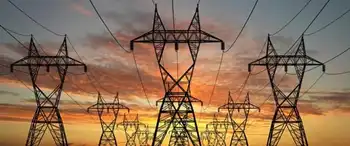OPG Unveils Tunnel Plans For Niagara Falls
TORONTO - - The world's largest boring machine is about to chew a 10-kilometre tunnel through solid rock at Niagara Falls, to tap more clean power for Ontario.
Tomorrow morning marks the official christening of Big Becky, a gigantic boring machine that will soon begin its two-year mission of drilling a 10.4 kilometre tunnel about 140 metres under the city of Niagara Falls.
The goal: tap more waterpower for generating electricity. It's not quite a voyage to the centre of the earth, but the sheer size of the project makes this an historic undertaking in the province.
"It's one of the largest hydroelectric projects in the world right now in terms of magnitude," said Emad Elsayed, vice-president of hydroelectric development at Ontario Power Generation (OPG).
The tunnel, which will run more than 100 metres below the city and be nearly three times the diameter of a subway tunnel in Toronto, will divert water flow from the Niagara River to the Sir Adam Beck generating stations, freeing up another 1.6 terawatt-hours of clean hydroelectricity a year for at least the next 100 years.
That's enough to power 160,000 homes annually, a welcome relief to a province in search of an energy fix.
Elsayed compares it to driving a car. "If you could go 100 kilometres on a tank full of gas, this project would make the tank a little bigger so you can go a longer distance," he explained. "It doesn't add more megawatts, but you can use what megawatts are produced more often." They're not adding more turbines, just more water flow for the existing turbines to use.
Construction on the $985 million project began last September and this giant wormhole is expected to be operational by the end of 2009.
Austrian engineering company Strabag AG was hired to design and create the tunnel, but Big Becky was built by Solon, Ohio-based Robbins Co. for about $30 million.
Owner OPG is touting Big Becky, named by high school students as part of a contest, as the world's largest boring machine. Some more impressive facts about this drill on steroids:
The diameter of its face is about 65 per cent larger than the boring machine that created the Chunnel under the English Channel that links England and France.
Big Becky is expected to bore through 10 to 12 metres of hard rock each day, but is capable of 15 metres per day.
Enough clean shale rock will be removed from the tunnel to fill a major-league baseball stadium. A conveyor belt carries the fractured rock back to the surface where the material is trucked away. Most of it will be used over the next five to 10 years to make bricks, clay tiles and other construction materials.
The boring machine has a large front cabin, lunchroom and a bathroom to support a crew of about 30. Crewmembers use minibuses to transport themselves to and from the machine.
"The tunnelling operation will be a seven-day, 24-hour operation with three shifts of workers," said Rick Everdell, project director for OPG.
"When they're underground they'll be underground for the full shift and will have all the facilities they need."
Drilling is likely to begin in early September. Once activated the front of the machine — which resembles a space capsule or an enormous showerhead — begins cutting into the hard rock with 85 half-metre studded blades.
It might sound like a noisy process, but OPG officials say vibrations from the drilling won't be felt on the surface.
When Big Becky resurfaces in mid-2008, it's likely that OPG will sell the machine back to Robbins Co. for other tunnelling projects around the world. Once a tunnel is built it tends to last for more than a century without requiring much maintenance, said Elsayed.
"We've sent submarines into the existing tunnels that are 50 years old, and they still look like new," he said.
Related News

After alert on Russian hacking, a renewed focus on protecting U.S. power grid
WASHINGTON - The joint alert from the FBI and Department of Homeland Security last month warning that Russia was hacking into critical U.S. energy infrastructure came as no surprise to the nation’s largest grid operator, PJM Interconnection.
“You will never stop people from trying to get into your systems. That isn’t even something we try to do.” said PJM Chief Information Officer, Tom O’Brien. “People will always try to get into your systems. The question is, what controls do you have to not allow them to penetrate? And how do you respond in the event they actually do get into your…




